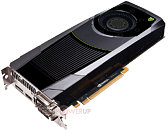Saturday, April 28th 2012

Third GK104-based Single GPU Graphics Card SKU Detailed
After GeForce GTX 680, which has all components of the 28 nm GK104 enabled, a dual-GPU GeForce GTX 690, which features two of these chips, and the GeForce GTX 670, NVIDIA is readying its third single-GPU GK104-based SKU. We know from older reports that this SKU could be named GeForce GTX 660 (Ti). A fresh report suggests that it will be carved out by disabling an entire graphics processing cluster (GPC) on the GK104 silicon, resulting in a CUDA core count of 1152; reducing the memory bus width of 192-bit GDDR5; and most likely reducing the ROP count to 24. This SKU could be used to capture a price point of around US $249, targeting AMD's Radeon HD 7800 series.
Source:
VideoCardz

51 Comments on Third GK104-based Single GPU Graphics Card SKU Detailed
GTX670 has to be around 350$ to take on 7950 and 7870 and this 660 will be up against 7850.
IMO the GTX660 will have the same clocks as the 670 and let the disabled parts be the only difference, that's what they did with the GTX465. On high resolution the 660 will come down a bit, but at 1920x1200 and below I think it's going to be close to the 670 (within a 10% give or take) and hence equal or faster than HD7870.
Now, on price they can obviously compete with current HD7850 price, because GK104 has always been meant for that price range. They could put som pressure down to $200 even, if required, but I doubt they will push AMD too much on that front because they don't have GK106 yet. They will just let AMD take the initiative more than likely. That means that $350 and $250 are not very likely IMO. More like $375 and $325, still offering slightly better value, but making a price cut a difficult decision.
Something must be disabled so as to clearly differentiate it from the 670 and it's better for a cheaper card to retain more of its shading/texturing/etc capabilities than retaining its ability for high resolutions because it's not going to be able to play on high resolutions anyway and people looking in that price range are less likely to have a 1600/1440p monitor. This way the differentiation is a slower card in general, but still powerful/close enough to the GTX 670 in 1080p and below, and with the catch that "on the 670 higher res is posible", so GTX670 also keeps its value. So better to have 1 cluster of everything disabled (balance) than 2 shader clusters disabled.
Only the "memory chips of variable densities to achieve 2 GB VRAM", not the "false branding to squeezing so much core clock to make up for lower shader count so you'll have ridicules power consumption, witch also lead to lame overclocking abilities".
:toast:
www.geeks3d.com/20120423/nvidia-gk110-the-true-7-billion-transistor-kepler-gpu/
The only card that justifies switching from my old GTX280SLI performance gap wise.
I mean if I were an investor and someone told me "hey lets just throw our best card out there for no financial reason" I would jump across the room and smack em into the unemployment office.
When Amd releases their dual 7900 card then maybe . . . . . ..
$300+ for a mid range gpu is insane (I'm not even counting GTX 680 as mid-range, but the gpu's intended to be mid range from ati 7870/7850 and upcoming models from Nvidia)
7870 Down to $220.00 in 2 ou 3 months would be very nice.... but not great when we think back in time to the HD4xxx generation.... the best bang for the buck ever generation... :banghead:
What it might make sense and/or be interesting to do is suggest a consumer buying model that Nvidia's specification strategy might imply them to believe in if they choose not to give this card 2GB of VRAM. Two examples are:
- Consumers weigh up cards given a budget based on some weighted addition of factors. Having more VRAM is one factor, performance is another, power consumption another, proximity to limit of price range another. In this case consumers with modest budgets, unlikely to be able to afford large monitor setups, give a fairly small weighting to VRAM quantity and Nvidia's tactics pay off.
Naturally this list is by no means exhaustive.Both of those models work on the assumption that once consumers are buying cards this expensive (as opposed to 2GB GT440s), they are no longer considering VRAM quantity as the ultimate determinant of graphical performance.
Of course even if Nvidia do give this card 2GB of VRAM, which they might yet do, this doesn't imply that they're aiming this card at people who need it - it just implies that they're aiming this card at people who think that they need it.
If the GTX 680 can just about outperform the 7970 with just 2GB of VRAM, then 1.5 GB would be fine.
Here's a guess:
660 non-Ti : 1280-1536 MB, 192 bit
650/650Ti : 1024 MB, 128 bit
also if consumers can decide their "budget" based on weighing in factors its not really a budget. A budget should be a set amount and cant go any higher; if you can randomly go "erm i think ill spend 150 more for the next tier" then your not really on a budget or your going in debt.